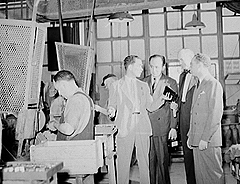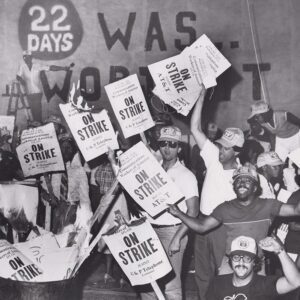August 31, 2010
Forty Years Later, The Fight for Safety in the Workplace Goes On
“With the support of labor unions and businesses alike, the OSH Act was signed into law on Dec. 29, 1970”
Before passage of the Occupational Safety and Health Act in December 1970, millions of Americans risked their lives every time they reported for duty: There were no national safety laws to protect workers.
Forty years ago, the groundbreaking legislation created the Occupational Health and Safety Administration (OSHA), which is responsible for setting workplace safety and health regulations — and ensuring that employers nationwide comply with them.
Risking Lives on the Job
In the 1800s, young factory workers were often mauled in grisly workplace accidents. The untrained suffered fatal injuries or lost limbs when they were caught in unsafe machinery. In 1877, Massachusetts passed the nation’s first factory-inspection bill, and other states passed similar measures. State laws, however, were largely ineffective: Many industries were not covered, and enforcement was weak. 
Newspapers reported tens of thousands of workplace deaths each year, the majority of which occurred due to employers’ blatant disregard for worker safety.
On March 25, 1911, the Triangle Shirtwaist Factory fire in New York City killed nearly 146 garment workers — mostly young women — and was the worst workplace disaster of its kind in New York. Managers had locked doors to stairwells and exits to prevent workers from taking breaks outside. The sweatshop inferno captured public attention and sparked a nationwide movement, led by unions and Progressive Era journalists, to improve safety standards in factories.
A Slow Start
Although Congress created the Department of Labor (DOL) in 1913, most workplace regulation was left up to individual states, which declined to sufficiently fund inspection procedures and enforcement measures.
In the 1930s, President Franklin D. Roosevelt appointed Frances Perkins, an outspoken advocate for workplace safety, as Secretary of Labor. With strong union support, Perkins helped create the Bureau of Labor Standards in 1934 to ensure workplaces were “as safe as science and law can make them.”
In 1936, Congress enacted the Walsh-Healey Public Contracts Act, which barred companies with hazardous worksites from obtaining federal contracts. But the legislation applied only to specific industries, ignoring much of the public and private sectors.
For the next three decades, union efforts to expand workplace safety laws were slowed by opposition from employers, who found it cheaper to replace dead or injured workers than to create safe workplaces.
Health and Safety ‘Crisis’
In 1965, the U.S. Public Health Service issued a startling report, titled “Protecting the Health of Eighty Million Americans,” which found that a new chemical entered the workplace every 20minutes, and that evidence now showed a strong link between cancer and the workplace. It also reported that old problems were far from being eliminated, and called for a major national campaign to improve occupational health.
 At the urging of labor organizations, President Lyndon B. Johnson agreed to establish a task force to draft a proposal, but due to internal bickering, the committee was deadlocked. In January 1968, LBJ declared hazardous workplace conditions a “national crisis” and submitted a safety and health bill to Congress that charged the DOL with establishing nationwide, mandatory safety standards. Federal inspectors would be given the authority to investigate worksites and penalize violators.
At the urging of labor organizations, President Lyndon B. Johnson agreed to establish a task force to draft a proposal, but due to internal bickering, the committee was deadlocked. In January 1968, LBJ declared hazardous workplace conditions a “national crisis” and submitted a safety and health bill to Congress that charged the DOL with establishing nationwide, mandatory safety standards. Federal inspectors would be given the authority to investigate worksites and penalize violators.
Pro-business lobbyists and “states’ rights activists” fought President Johnson’s plan, claiming it would needlessly expand business regulation. While labor groups commended Johnson’s proposals, the bill ultimately failed to gain congressional support.
On Nov. 20, 1968, an explosion at the Consol Energy coal mine near Farmington, WV killed 78 workers. Former mine foreman Pete Sehewchuk said the mine was in terrible shape; that productivity was considered more important than safety, and that the explosion could have been prevented. “I told my wife at that time, ‘That mine is going to blow up.’ There are a lot of shady things that went on back there,” Sehewchuk said in a 2008 interview with National Public Radio.
While the Consol Energy incident led to a strict mine-safety law in 1969, workplace casualties continued to rise at an accelerated rate: That year, the Secretary of Labor reported that injuries in the workplace had increased 20 percent since 1958 — bringing the total number of annual injuries to 2.2 million.
A Labor-Management Debate
Seeking support from blue-collar workers, in August 1969, newly-elected president Richard Nixon announced his support for a modified version of Johnson’s proposal. Nixon’s bill gave the Labor Department responsibility for workplace inspection, but called for the creation of a five-person board, appointed by the president, to establish national health and safety standards.
Business leaders, led by the U.S. Chamber of Commerce, commended Nixon’s plan, but labor leaders opposed the concept of a presidentially-appointed board: They wanted the responsibility for enforcement to remain under the jurisdiction of the Department of Labor. Union activists thought the plan would penalize only those employers whose workplaces were inspected and found to be in violation of safety standards: They believed the bill lacked sufficient “deterrent” value.
Organized labor supported an alternative Senate bill offered by Democrats that rejected Nixon’s division of Labor Department authority. The labor-management debate remained in congressional limbo for more than a year.
In November 1970, the two parties reached an agreement: Congressional Republicans agreed to create a new agency — the Occupational Health and Safety Administration (OSHA) — which would inspect workplaces, and Democrats agreed to a separate appointed group that would review and judge cases involving industry violations. With the support of labor unions and businesses alike, President Nixon signed the bill into law on Dec. 29, 1970.
A Lasting Impact
Under the provisions of the new law, OSHA was created to improve and enforce safety standards to reduce workplace hazards; to research occupational safety and health; to maintain a record-keeping system to track violations and work-related casualties, and to establish occupational safety training programs.
Critics of OSHA say that safety standards are often “watered down” in response to pressure from business groups, and complain that the agency is frequently slow in developing safety standards and issuing violations. But in the 40 years since the enactment of the OSH Act, workplace safety has improved dramatically. Fatalities and debilitating injuries have decreased significantly; occupational diseases such as “brown lung” have all but disappeared, and OSHA standards are in place to limit workplace exposure to asbestos, lead, cotton dust, and other hazardous material on the job.
Recently, postal workers have seen the important role OSHA can play in enforcing workplace safety. The agency has cited the Postal Service for ongoing and systemic electrical safety violations at facilities across the country. At the end of August, the Postal Service’s total OSHA fines exceeded $4.4 million.



